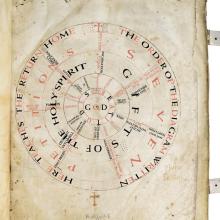middle ages
If much of life in the High Middle Ages seems foreign to us, the detailed workings of the wheel — along with four others like it that have survived to the present — are a real riddle.
Schematic prayer guides were more common in later centuries, said Lauren Mancia, a medievalist at Brooklyn College who has examined the Liesborn Wheel.
“Monks and nuns in the Central Middle Ages often get a bad rap for unsystematic thinking — doing all this prayer by rote, mumbling, and not caring about the sense,” said Mancia.
“This diagram suggests that they’re not just mumbling, they’re using a mnemonic device to remember and internalize, or even to make an inner journey.”
Let’s be clear: April Fools’ Day is not a religious holiday.
It does, however, trace its origins to a pope.
The day began, most believe, in 1582, when Pope Gregory XIII decreed the adoption of the “Gregorian calendar” — named after himself — which moved New Year’s Day from the end of March to Jan. 1.
The change was published widely, explains Ginger Smoak, an expert in medieval history at the University of Utah, but those who didn’t get the message and continued to celebrate on April 1 “were ridiculed and, because they were seen as foolish, called April Fools.”

